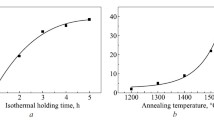Abstract
The ternary system Ti−Cr−N has been investigated by X-ray powder technique and by metallographic methods in two isothermic sections at 1000° C and 1200° C. The isotypic mononitrides TiN and CrN form a complete series of solid solutions, theVegard's curve shows a slight negative deviation from linearity. No ternary compound could be observed. A tentative phase diagram for an isothermic section at 1000° C is given.
Investigation of the systems Zr−Cr−N and Hf−Cr−N was restricted to the pseudobinary sections ZrN−CrN and HfN−CrN. To ensure the stability of the less stable component (CrN) the following pressure conditions were chosen: 1 atm N2 at 1000° C, 30 atm N2 at 1200° C, 250 atm N2 at 1400° C. The isotypic compounds ZrN and CrN exhibit a miscibility gap, which diminishes with increasing temperature. The cirtical point can be estimated to be at 1440° C and 50 mol% ZrN. In the pseudobinary system HfN−CrN a complete series of solid solutions could be observed. A miscibility gap should occur, if ever, at temperatures below 1000° C.Vegard's curve for the lattice parameters of the solid solutions (Hf, Cr)N shows a slight positive deviation from linearity.
Zusammenfassung
Das ternäre System Ti−Cr−N wurde bei 1000° C und 1200° C mit Hilfe von metallographischen und röntgenographischen Methoden untersucht. Die Mononitride TiN und CrN bilden eine lückenlose Reihe von Mischkristallen; dieVegardsche Kurve weicht schwach negativ von der Geraden ab. Es konnte keine ternäre Verbindung gefunden werden. Für 1000° C wird ein Vorschlag für einen isothermen Schnitt durch das System Ti−Cr−N entworfen.
Die Untersuchungen in den Systemen Zr−Cr−N und Hf−Cr−N beschränkten sich auf den Bereich der pseudobinären Schnitte ZrN/CrN und HfN/CrN. Um die Stabilität des weniger stabilen CrN sicherzustellen, wurden bei den Versuchstemperaturen folgende Stickstoffdruck-Bedingungen gewählt: 1 at N2 bei 1000° C, 30 at N2 bei 1200° C und 250 at N2 bei 1400° C.
Die isotypen Phasen ZrN und CrN zeigen eine Mischungslücke; aus dem Temperaturverlauf der Mischungslücke kann angenommen werden, daß sie sich bei 1440° C und 50 Mol% ZrN schließt.
Im pseudobinären System HfN−CrN konnte im untersuchten Temperaturbereich lückenlose Mischbarkeit zwischen den Komponenten festgestellt werden. Eine Entmischung tritt, wenn überhaupt, nur bei Temperaturen unterhalb 1000° C auf. DieVegardkurve der Gitterparameter der Mischkristalle zeigt eine schwach positive Abweichung von der Geraden.
Similar content being viewed by others
Author information
Authors and Affiliations
Additional information
Herrn Prof. Dr.H. Nowotny gewidmet.
Mit 6 Abbildungen
Auszug aus der von der Fakultät für Naturwissenschaften der T. H. Wien approbierten Doktor-Dissertation des Herrn Dipl.-Ing.F. Petter.
Rights and permissions
About this article
Cite this article
Kieffer, R., Ettmayer, P. & Petter, F. Beitrag zur Kenntnis der Systeme Titan—Chrom—Stickstoff, Zirkonium—Chrom—Stickstoff und Hafnium—Chrom—Stickstoff. Monatshefte für Chemie 102, 1182–1196 (1971). https://doi.org/10.1007/BF00917172
Received:
Issue Date:
DOI: https://doi.org/10.1007/BF00917172



